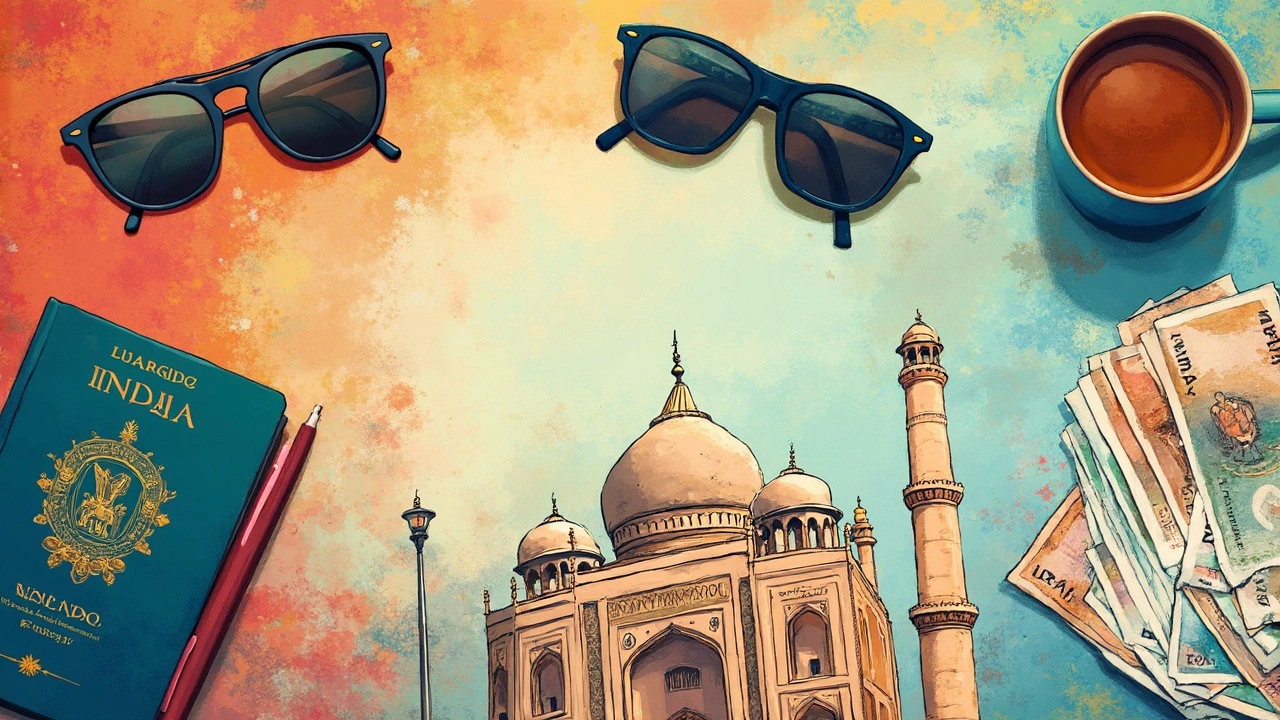How Much Money Can a US Citizen Take to India?
 Apr, 15 2025
Apr, 15 2025
So you've booked your flight to India, and now you're wondering, 'How much cash can I take?' The answer's not as wild as it seems, but it's a biggie for smooth travels. India has specific cash carrying rules, and knowing them means less stress and more fun.
First off, let's get practical. You might've heard that carrying too much cash can land you in hot water. For US travelers heading to India, carrying cash is fine, but only to a limit without declaring it. Right now, you can't bring more than $5,000 in cash without shouting it out at customs. Got more? You’ll need to fill out a form and let the authorities know. Easy-peasy, right?
- Understanding Cash Limits
- Currency Declaration Rules
- Smart Money Management Tips
- Useful Travel Hacks
Understanding Cash Limits
If you're gearing up for a trip to the colorful chaos that is India, you might wonder, 'How much cash should I bring, and what are the rules?' It's crucial to understand these cash limits before you hop on that plane from the US.
First things first, there's a ceiling on carrying large sums of money into India. As a US citizen, you can bring in up to $5,000 in cash without needing to declare it to customs. Want to bring more? No problemo, but you'll need to declare amounts exceeding $5,000 in cash. Just make sure you fill in the Currency Declaration Form (CDF) when you land.
Not only cash but there's also a limit on bringing in other types of monetary instruments like traveler’s cheques. If the cumulative sum of these exceeds $10,000, you need to declare it too. This way, you stay on the right side of the law and avoid any awkward situations at the airport.
Got questions on the logic behind these rules? Well, it's all part of controlling foreign exchange and ensuring travelers are not participating in any funny business. And honestly, would you want to be lugging around enough cash to fill a mattress? Probably not! Digital travel money cards and reliable bank services back home make it super easy to manage your finances abroad without carrying wads of cash.
Knowing these limits not only saves you from fines but also helps you allocate your budget smartly. Remember, these limits aren't just numbers; they're about ensuring your adventure in India starts and ends without a hitch. Safe travels!
Currency Declaration Rules
When traveling from the US to India, it's crucial to understand the rules around declaring large amounts of money. No one wants a snafu at the airport, right? The Indian customs rules state that if you bring in more than $5,000 in cash, or a total of $10,000 in cash plus traveler's checks, you gotta declare it when you arrive. This process keeps you out of hot water and helps the government curb money laundering and tax evasion.
Here's how you do it:
- Look for the 'red channel' at customs. That's the lane where you declare any dutiable goods, including the funds exceeding the limit.
- Fill out the Currency Declaration Form (CDF), which you can snag at the airport or sometimes even on the plane. It's pretty straightforward, asking for details about the amount and form of currency you're carrying.
- Hand over this form to the customs officer. They'll probably ask you a couple of questions, and then you're good to go.
Super simple once you know what to expect, right? And here's a quick tip: always have some proof, like receipts or bank statements, if you're carrying a significant amount, just in case questions arise.
According to a finance expert at Foreign Exchange Analytics, “Proper declaration not only ensures smooth travel but also protects you from unnecessary legal intricacies.”
Stick to these naming conventions and you’ll not only avoid penalties but also save a ton of time during your travels. Remember, staying informed is half the battle.

Smart Money Management Tips
Taking a trip to India on a budget is totally doable, but you'll need to be smart about how you manage your money there. Before you go, it's important to plan ahead and think about how you’ll handle your finances abroad.
Firstly, it's a good idea to split your money into different forms. Sure, cash is king in many places, but don't forget about using credit cards and travel money cards. They’re lifesavers when it comes to safety and convenience. And hey, do make sure those cards work internationally and aren’t racking up crazy fees! You know what a buzzkill that can be.
A familiar name in traveling, Rick Steves, put it well:
“Travel is intensified living...and one of those realities involves being careful and wise about your money.”
Now, don’t get caught off guard by credit card foreign transaction fees. Some U.S. cards actually offer no foreign fees and are real lifesavers abroad. It might be worth calling your bank to see if you can snag one before you head out.
When it comes to exchanging cash, always avoid doing it at airports where rates are sky-high. Instead, opt for official exchange centers or banks. Even better, withdraw Indian rupees directly from ATMs using a travel-friendly bank card that doesn’t charge for international withdrawals.
- Keep emergency cash hidden in different places—like your luggage or a money belt—just in case.
- Use digital wallets for quick and easy payments. Apps like Paytm or Google Pay are popular in India and can make transactions a breeze.
- Monitor exchange rate fluctuations. You can save or lose quite a bit depending on when you exchange your money.
If you've got a budget in mind, sticking to it is key. Little expenses like chai here and there can add up quickly!
| Payment Method | Ideal Use Case | Potential Fees |
|---|---|---|
| Cash | Local markets, small eateries | None |
| Credit Card | Hotels, major retailers | Up to 3% on transactions |
| Travel Card | Multiple currencies use | Fixed ATM withdrawal fees |
So there you have it! Keep it simple and straightforward, and you'll navigate your budget-friendly India trip like a pro. Bon voyage!
Useful Travel Hacks
When it comes to budget travel in India, a few clever tricks can stretch your dollar further. Let's dive into some handy hacks that can make your trip smoother and keep your wallet happy.
Digital is King: First and foremost, embrace digital payments. Apps like Paytm and Google Pay are everywhere in India. They're super convenient for paying local shops, ordering food, and even booking rides. Plus, you keep track of spending without juggling too many notes.
ATM Wisdom: Need cash? Skip currency exchange kiosks at airports—they usually offer poor rates. Instead, find an ATM once you're in the city. Look for banks like SBI or ICICI for dependable service.
Bargain Smart: Love shopping? Bargaining is a sport in Indian markets. Start by asking for a deal; many vendors expect it. But stay polite and friendly. They value a good rapport, and it's all part of the experience!
Public Transport Rocks: Cities like Delhi and Mumbai have efficient metro systems. They're cheap and often the fastest way around town. For longer distances, trains are an adventure in themselves and way easier on the pocket than flights.
Finally, here's a snapshot of typical expenses in local currency to help plan your budget better:
| Item | Cost (INR) |
|---|---|
| Metro Ride | 20-50 |
| Street Food Snack | 30-50 |
| Budget Hotel Night | 800-1200 |
| Souvenir | 100-300 |
By mastering these travel tips, you can dive into India's vibrant culture without worrying about breaking the bank.